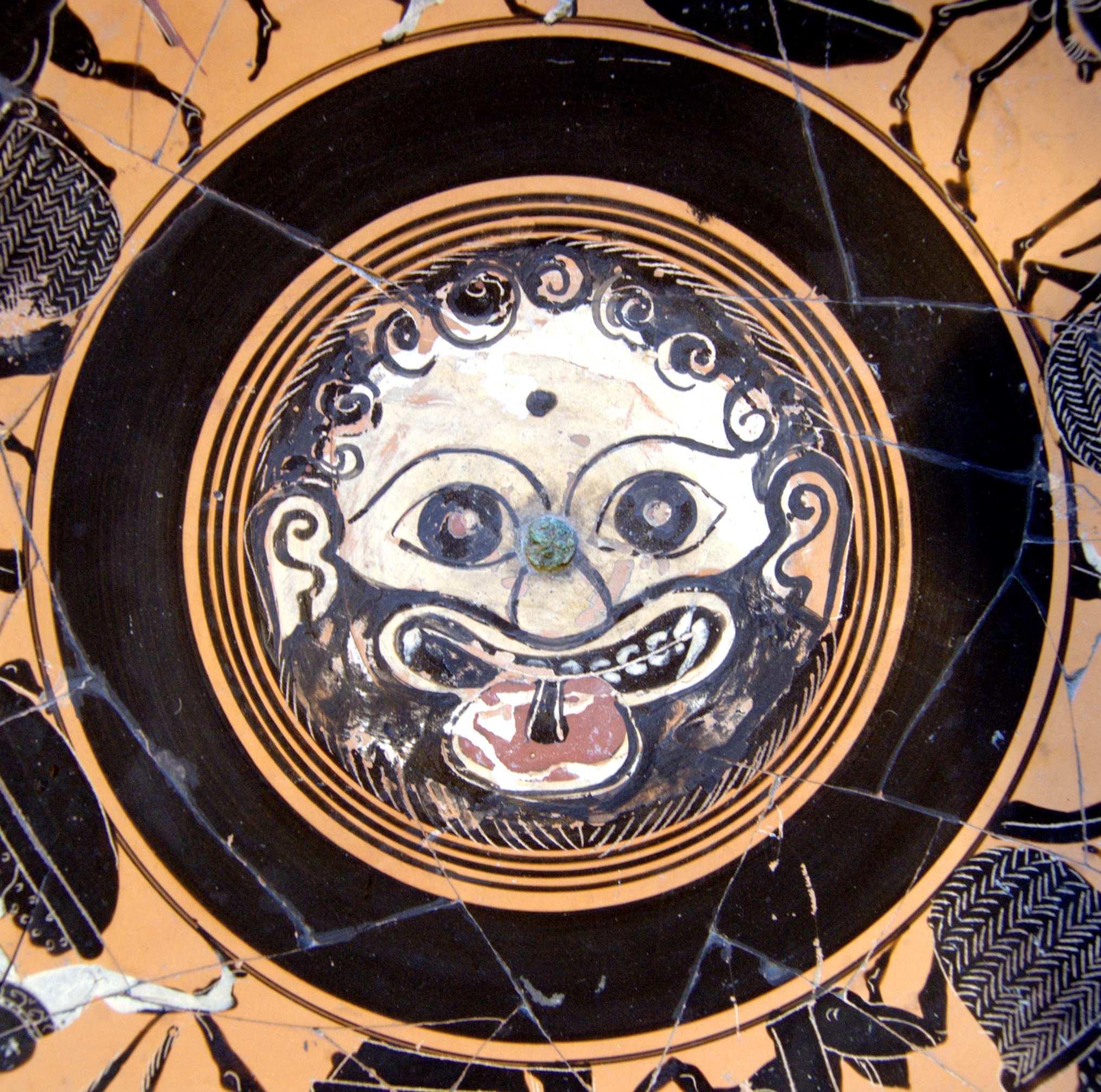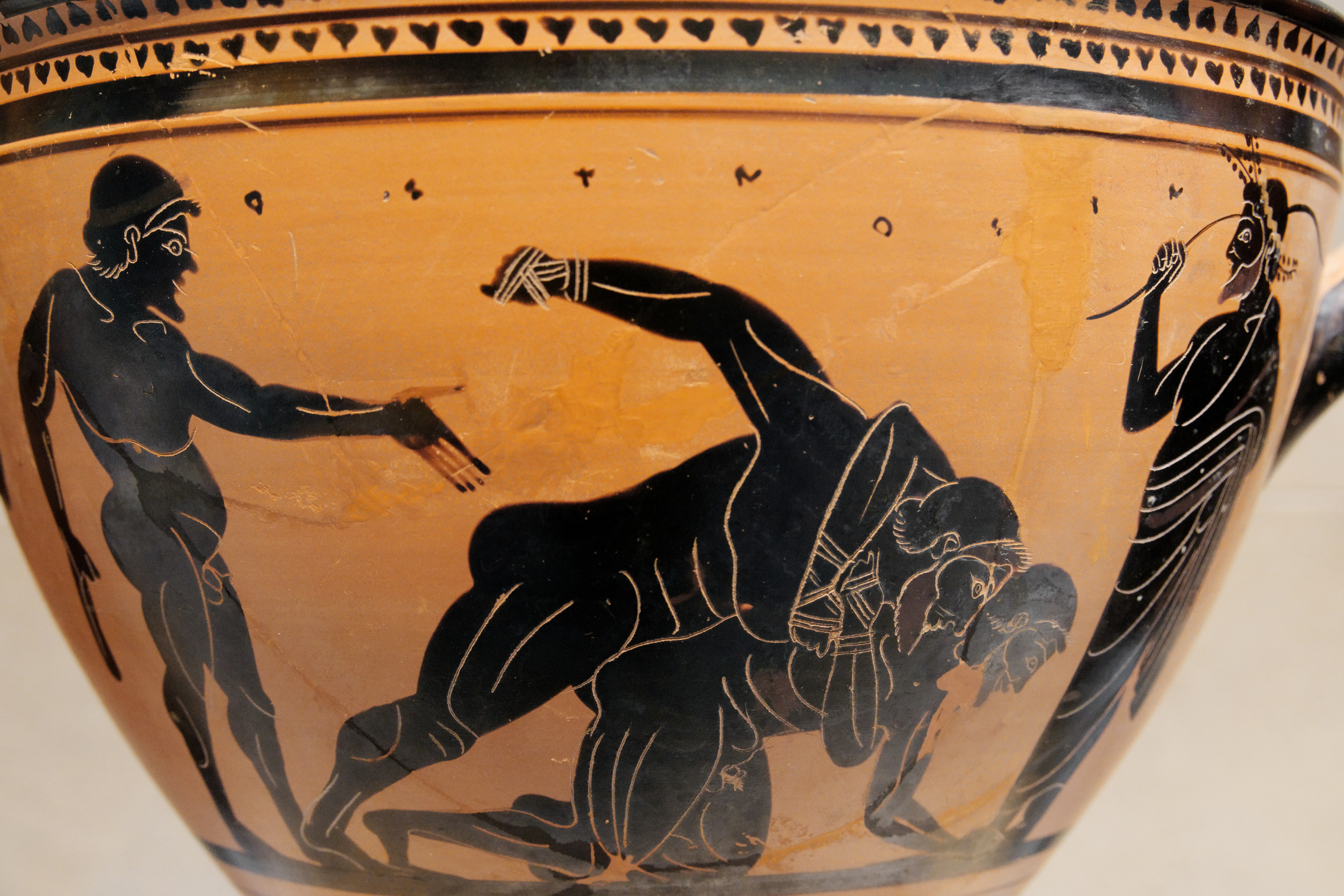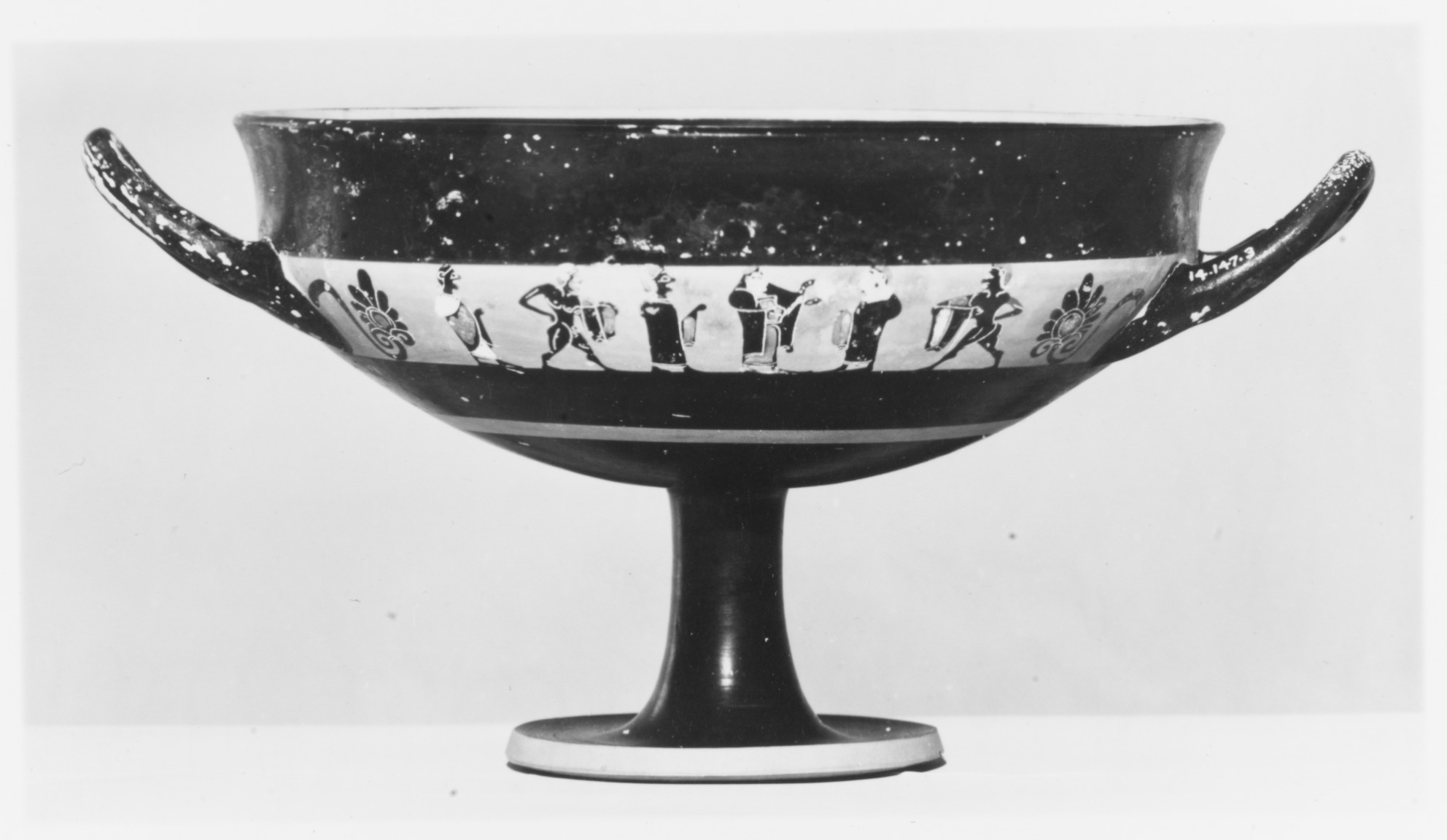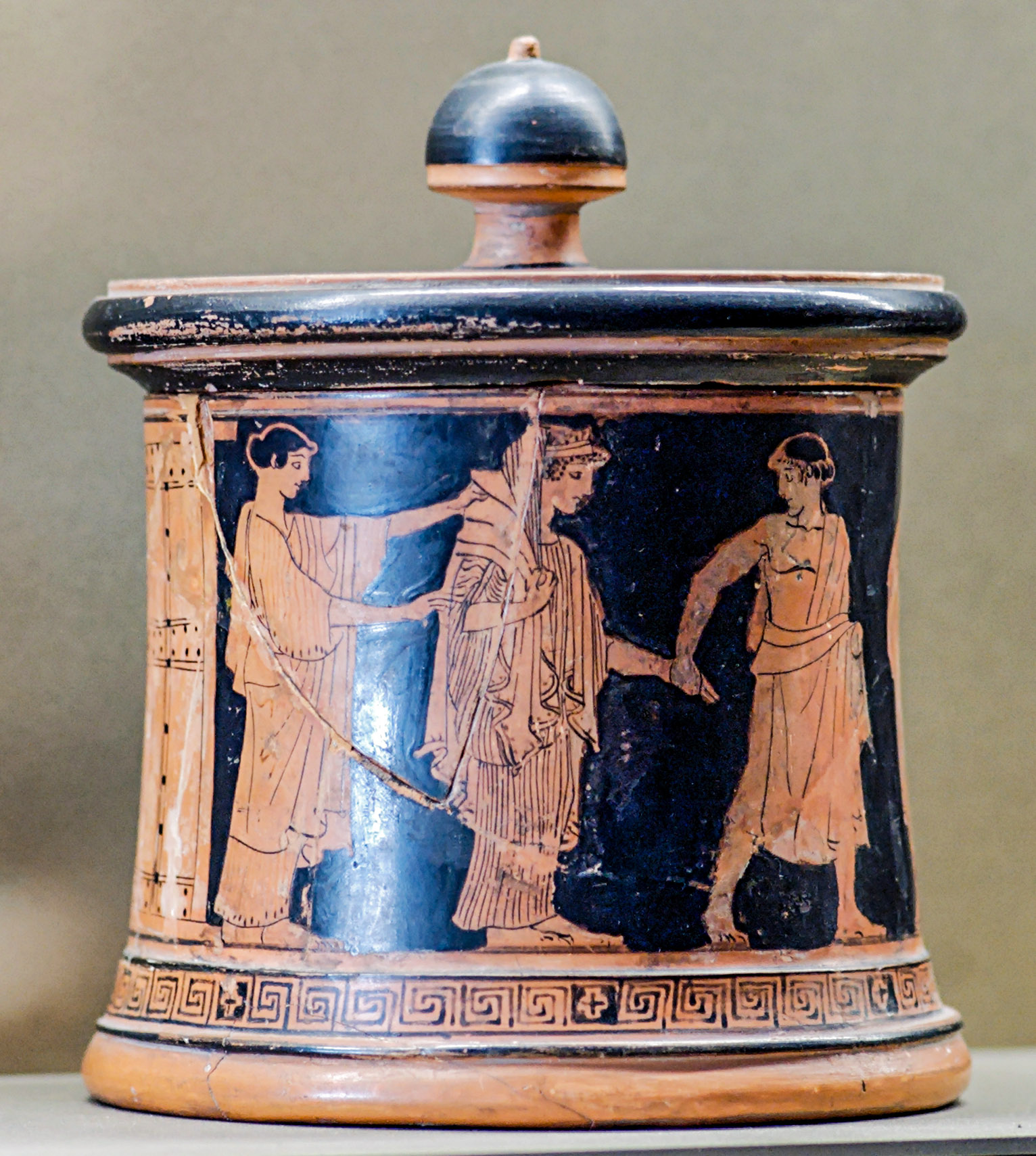|
Nikosthenes Painter
Nikosthenes was a potter of Greek black- and red-figure pottery in the time window 550–510 BC. He signed as the potter on over 120 black-figure vases, but only nine red-figure. Most of his vases were painted by someone else, called Painter N (for Nikosthenes). Beazley considers the painting "slovenly and dissolute;" that is, not of high quality. In addition, he is thought to have worked with the painters Anakles, Oltos, Lydos and Epiktetos. Six's technique is believed to have been invented in Nikosthenes' workshop, possibly by Nikosthenes himself, around 530 BC. He is considered transitional between black-figure and red-figure pottery. The pottery workshop Nikosthenes was the owner of a workshop in Athens in the latter part of the 6th century BC. On the theory that the number of signed works reflects the number of total works, the high number of signatures referring to Nikosthenes suggests that he had one of the largest if not the largest manufacturing center in Athens. H ... [...More Info...] [...Related Items...] OR: [Wikipedia] [Google] [Baidu] |
Paris
Paris () is the capital and most populous city of France, with an estimated population of 2,165,423 residents in 2019 in an area of more than 105 km² (41 sq mi), making it the 30th most densely populated city in the world in 2020. Since the 17th century, Paris has been one of the world's major centres of finance, diplomacy, commerce, fashion, gastronomy, and science. For its leading role in the arts and sciences, as well as its very early system of street lighting, in the 19th century it became known as "the City of Light". Like London, prior to the Second World War, it was also sometimes called the capital of the world. The City of Paris is the centre of the Île-de-France region, or Paris Region, with an estimated population of 12,262,544 in 2019, or about 19% of the population of France, making the region France's primate city. The Paris Region had a GDP of €739 billion ($743 billion) in 2019, which is the highest in Europe. According to the Economist Intelli ... [...More Info...] [...Related Items...] OR: [Wikipedia] [Google] [Baidu] |
Nikosthenic Amphora
A Nikosthenic amphora is a type of Attic vase invented in the late 6th century BC by the potter Nikosthenes, aimed specifically for export to Etruria. Inspired by Etruscan Bucchero types, it is the characteristic product of the Nikosthenes-Pamphaios workshop. Characteristic features are the angular body of the amphora and the broad flat handles. The Etruscan predecessors were black-painted, whereas the Attic vases were decorated in the black-figure style. Nearly all know examples were found in Caere, while the majority of Nikosthenes products in other shapes were discovered in Vulci. This suggests that the type was specifically made for sale in or to Caere, which indicates that Nikosthenes must have been a gifted salesman and that an efficient system of intermediate traders must have existed. Niksothenes created or introduced several vase shapes, but the Nikosthenic amphora is his most famous innovation. The clay of the Nikosthenic amphorae is bright orange-red, and thus provi ... [...More Info...] [...Related Items...] OR: [Wikipedia] [Google] [Baidu] |
Ancient Greek Potters
Ancient history is a time period from the beginning of writing and recorded human history to as far as late antiquity. The span of recorded history is roughly 5,000 years, beginning with the Sumerian cuneiform script. Ancient history covers all continents inhabited by humans in the period 3000 BCAD 500. The three-age system periodizes ancient history into the Stone Age, the Bronze Age, and the Iron Age, with recorded history generally considered to begin with the Bronze Age. The start and end of the three ages varies between world regions. In many regions the Bronze Age is generally considered to begin a few centuries prior to 3000 BC, while the end of the Iron Age varies from the early first millennium BC in some regions to the late first millennium AD in others. During the time period of ancient history, the world population was already exponentially increasing due to the Neolithic Revolution, which was in full progress. While in 10,000 BC, the world population stood at ... [...More Info...] [...Related Items...] OR: [Wikipedia] [Google] [Baidu] |
Gorgoneion
In Ancient Greece, the Gorgoneion (Greek: Γοργόνειον) was a special apotropaic amulet showing the Gorgon head, used by the Olympian deities Athena and Zeus: both are said to have worn the gorgoneion as a protective pendant,. and often are depicted wearing it. It established their descent from earlier deities considered to remain powerful. Among other attributes, it was assumed by rulers of the Hellenistic age as a royal aegis to imply divine birth or protection, as shown, for instance, on the Alexander Mosaic and the Gonzaga Cameo. Origin According to Marija Gimbutas, ''gorgoneia'' represent certain aspects of the Mother Goddess cult associated with "dynamic life energy" and asserts that the images may be related to a cultural continuity persisting since the Neolithic period defining the ''gorgoneion'' as a quintessentially European image. Jane Ellen Harrison, on the other hand, claims that many primitive cultures use similar ritual masks in order to scare the owner fr ... [...More Info...] [...Related Items...] OR: [Wikipedia] [Google] [Baidu] |
Lysippides Painter
The Lysippides Painter was an Attic vase painter in the black-figure style. He was active around 530 to 510 BC. His conventional name comes from a kalos inscription on a vase in the British Museum attributed to him; his real name is not known. Life and work His conventional name is derived from a ''kalos'' inscription on a neck amphora in the British Museum (B 211). He is considered the most significant pupil of Exekias, from whom he adopted not only his artistic style but also some important motifs, such as Ajax and Achilleus playing a board game. He also frequently painted scenes involving the hero Herakles. In total, about 30 known vases are ascribed to him. His collaboration with the Andokides Painter, usually considered the inventor of red-figure vase painting, is unusual. On seven bilingual vases, six belly amphorae and a cup (now in Palermo), he painted the red-figure side, while the Andokides Painter was responsible for the black-figure one. At times, the subjects ... [...More Info...] [...Related Items...] OR: [Wikipedia] [Google] [Baidu] |
Andokides (potter)
Andokides (; ''The Columbia Electronic Encyclopedia'', 6th ed., Columbia University Press, 2012. el, Ἀνδοκίδης) was a famous of . The painter of his pots was an anonymous artist, the , who is recognized as the creator of the |
Theseus Painter
The Theseus Painter was a decorator of vases in the black-figure style, active in Attica c. 515 to 475 BCE. Later published as He was the leading producer of larger Heron Class skyphoi. Life and work The true name of the Theseus Painter and the circumstances of his life have not been preserved. He is conventionally called the Theseus Painter because of the frequency with which he and his followers depicted various episodes of the ''Theseid'', the peregrinations of Theseus. Stylistic evidence indicates that he was contemporaneous with and a "dominant influence" among the Sub-krokotos group, and was perhaps a student of Pamphaios. He established his own workshop in Attica with the Athena Painter, and together they specialized in the production of skyphoi, lekythoi, and oinochoai in the black-figure style. Although the more fashionable red-figure style had largely displaced the black-figure style at the turn of the sixth century, his work nonetheless enjoyed a certain meas ... [...More Info...] [...Related Items...] OR: [Wikipedia] [Google] [Baidu] |
BMN Painter
The BMN Painter was an Attic vase painter in the black-figure style, active during the third quarter of the 6th century BC. Initially, the BMN Painter worked for the potter Lydos. Of the collaboration between the two, a band cup and a belly amphora are known. John Boardman sees the BMN Painter as both the earliest and the best vase painters to collaborate with the important potter Nikosthenes. The earliest works by them are a Siana cup and several Little-master cups, including a lip cup signed by Nikosthenes. The BMN Painter was the most significant representative of the Bellerophontes Class. He probably painted the majority of works by that grouping, including the name vase, depicting Bellerophontes fighting the chimaira. The abbreviation BMN that provides his covnetional name stands for "British Museum" and "Nikosthenes" and refers to his name vase, inventory B 295 in that museum. Bibliography * John Beazley Sir John Davidson Beazley, (; 13 September 1885 – 6 May ... [...More Info...] [...Related Items...] OR: [Wikipedia] [Google] [Baidu] |
Psiax
Psiax was an Attic vase painter of the transitional period between the black-figure and red-figure styles. His works date to ''circa'' 525 to 505 BC and comprise about 60 surviving vases, two of which bear his signature. Initially he was allocated the name "Menon Painter" by John Beazley. Only later was it realised that the artist was identical with the painters signing as "Psiax". Psiax collaborated with the potters Hilinos, Menon, Andokides and Nikosthenes. While he started as a painter in the black-figure technique, he played a major role in the early development of red-figure, which was invented in the workshop of Andokides. The black-figure Antimenes Painter, working for the same workshop, was stylistically close to Psiax; Beazley described the two as "brothers". Perhaps unsurprisingly, considering his chronological position, Psiax was a master of bilingual vase painting. Formerly called the Menon Painter, after the potter’s signature on a red-figure amphora (Philadelph ... [...More Info...] [...Related Items...] OR: [Wikipedia] [Google] [Baidu] |
Pamphaios
Pamphaios was an Attic potter active around the end of the 6th century BC. Pamphaios was the successor of Nikosthenes in that artist's workshop, and thus took over from one of the most influential and creative potters of antiquity. He probably took over the workshop before 510 BC and continued the tradition of his predecessor by producing typical shapes the latter had developed, such as the Nikosthenic amphora, the Nikosthenic pyxis or the Chalkidian style cup. At times, he developed these shapes further. Unlike Nikostehenes, Pamphaios favoured painters of the red-figure style, which was at the time replacing the previously dominant technique of black-figure vase painting. He also continued to employ many of the painters that had worked for Nikosthenes, such as Oltos, Epiktetos and the Nikosthenes Painter. Pamphaios signature survives on more than fifty vases – spelled different ways by various artists, it probably functioned as a trademark on his workshop's products. File:At ... [...More Info...] [...Related Items...] OR: [Wikipedia] [Google] [Baidu] |
Etruria
Etruria () was a region of Central Italy, located in an area that covered part of what are now most of Tuscany, northern Lazio, and northern and western Umbria. Etruscan Etruria The ancient people of Etruria are identified as Etruscan civilization, Etruscans. Their complex Etruscan civilization, culture centered on numerous city-states that arose during the Villanovan period in the ninth century BCE, and they were very powerful during the Orientalizing Archaic period in Greece, Archaic periods. The Etruscans were a dominant culture in Italy by 650 BCE,Rix, Helmut. "Etruscan." In ''The Ancient Languages of Europe,'' ed. Roger D. Woodard. Cambridge University Press, 2008, pp. 141–164. surpassing other ancient Italic peoples such as the Ligures. Their influence may be seen beyond Etruria's confines in the Po River Valley and Latium, as well as in Campania and through their contact with the Magna Graecia, Greek colonies in Southern Italy (including Sicily). Indeed, at some Etrusc ... [...More Info...] [...Related Items...] OR: [Wikipedia] [Google] [Baidu] |
Pyxis (vessel)
A ''pyxis'' (, plural ''pyxides'') is a shape of vessel from the classical world, usually a cylindrical box with a separate lid. Originally mostly used by women to hold cosmetics, trinkets or jewellery, surviving ''pyxides'' are mostly Greek pottery, but especially in later periods may be in wood, metal, ivory, or other materials. The name derived from Corinthian boxes made of wood from the tree ''puksos'' (boxwood), that also came with covers. The shape of the vessel can be traced in pottery back to the Protogeometric period in Athens, however the Athenian ''pyxis'' has various shapes itself. At first, the two varieties of ''pyxis'' included the pointed and the flat-bottomed. The pointed ''pyxis'' didn't last much longer than the ninth century BCE, while the flat-bottomed continued into the late Geometric. It also continued to grow larger and more squat in proportions. The cover often depicts elaborately sculpted handles and the walls tend to be somewhat convex. During the ... [...More Info...] [...Related Items...] OR: [Wikipedia] [Google] [Baidu] |







